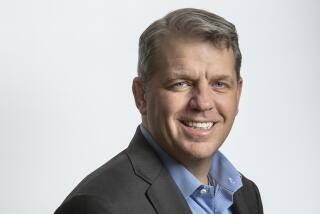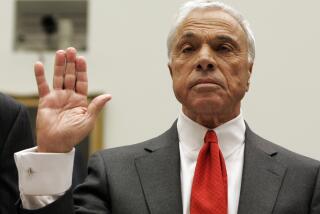Foothill Rises to Overcome Past Losses : Lender Again Getting Notice for Its Role in Nursing Ailing Firms
- Share via
During the last two years, Foothill Group Inc. has been forced to learn a new and unfamiliar way to make money--by losing it first.
The Los Angeles-based company had won praise in the 1970s and early 1980s as one of the nation’s fastest growing and most profitable commercial-finance firms, lending to new or ailing companies unable to get enough money from conventional bank loans.
But the firm’s brief foray into equipment leasing to Texas oil-service companies turned into a disaster, thanks to the energy glut and resultant collapse of oil prices. Foothill lost a combined $18.4 million in 1982 and 1983 and some thought it might follow many of its troubled oil-industry borrowers into bankruptcy.
But the losses apparently taught Foothill some valuable lessons. And today, after some painful restructuring--including office closings, layoffs, the sale of assets and management reorganization--and determined never again to stray from its primary business--Foothill is staging a dramatic comeback.
Profits, Morale Return
Replacing talk of bankruptcy is talk that 1985 will be one of Foothill’s best years ever. Profits are back, as is employee morale, which was shattered by the cost-cutting moves a year ago. The company, proclaiming itself the nation’s largest independent commercial-finance firm, confidently predicts that it will earn a 20% annual return on shareholders’ equity.
Instead of publicity about its own troubles, the firm once again is attracting attention for its long-time role in helping other struggling companies. Foothill most recently has been in the news as a lender to United Press International, the troubled wire news service, and Oak Industries Inc., the ailing San Diego-based cable-TV and media company.
In both cases, Foothill not only stands as a potential savior, but also stands to make a pretty profit. Both also illustrate Foothill’s success in serving high-risk businesses.
‘Where We Want to Be’
“We serve these markets about as good as anybody,” proclaims Don L. Gevirtz, Foothill’s controversial co-founder, chairman and co-chief executive, adding that the firm is “right where we want to be” in its comeback.
To be sure, Foothill’s problems are by no means over. The firm’s level of bad loans, while down dramatically from the 1982 peak, still is high by historical standards and could rise again if the economy weakens. And the firm faces increasing competition from banks and other institutions with greater resources and access to cheaper sources of funds for lending.
But, analysts agree, Foothill’s major energy-related nightmares are over. The firm has sold off much of its leasing equipment and written down the value of what remains.
“Any problems they will encounter in the future will be prospective problems, not based on what they have done in the past,” says analyst Harold M. Levine of the New York-based securities firm of Arnhold & S. Bleichroeder Inc. “They certainly won’t be hit again by energy involvement in Texas.”
Many Divestitures
Foothill’s painful lesson in sticking to the business that it knows best is a lesson being learned throughout corporate America these days, as companies that prospered by diversifying in the inflationary 1970s now are divesting themselves of many of their far-flung operations.
For years since its founding in the early 1970s, Foothill avoided diversification, amassing a string of profitable years by sticking to its core business of making asset-based loans to struggling companies or to start-up firms considered too new or speculative to suit bankers’ tastes.
In recognition of the higher risk, the interest rates on these loans were sometimes as much as six or seven points above the banking industry’s prime rate--the benchmark for loans to most credit-worthy borrowers--while Foothill’s cost of funds typically was around the prime rate.
Heavily Secured Loans
However, Foothill structured the loans so that they were anything but risky. Unlike many conventional bank loans not secured by assets, Foothill’s loans were heavily secured, usually by the borrower’s accounts receivable, equipment or buildings.
To reduce its risk even further, Foothill typically secured far more collateral than the value of the loan, in some cases even securing borrowers’ private homes. If the borrower went belly up, Foothill was usually first in line to collect its assets.
Such activity turned out to be very profitable.
“They made out like bandits,” says analyst Levine of Foothill’s profits from lending to Sambo’s Restaurants Inc. during the restaurant chain’s unsuccessful two-year effort to reorganize under Chapter 11 of the federal bankruptcy laws. Overall, Foothill lent to about 15,000 small- to medium-sized firms, and also financed several leveraged buy-outs and other takeovers.
Fueled Ambitions
Foothill’s success fueled Gevirtz’s ambitions as an economic guru and rising star in Democratic Party politics. Preaching the key role of entrepreneurs in reviving the American economy, Gevirtz was a close economic adviser to such politicians as Sen. Gary Hart (D-Colo.) and former Vice President Walter F. Mondale. He was even touted as a potential Cabinet-level appointee in a Democratic administration.
Foothill’s other co-founder, John F. Nickoll, meanwhile, was winning respect for his keen ability to size up lending opportunities in his role as the company’s president and co-chief executive in charge of running day-to-day operations.
“Nickoll is a genius in the industry,” says Farhad Motia, a former Foothill vice president and now chief credit officer at Los Angeles-based Sterling Bank, echoing a widely held sentiment in the commercial-finance industry.
Genius Not Enough
But Nickoll’s genius was not enough to foresee that the oil industry’s good times in the late 1970s would turn to disaster in the early 1980s.
Attracted by the lure of profits from the oil patch and the need for investment tax credits to shelter its growing profits, Foothill in the late 1970s entered the business of leasing machine tools and other equipment, mostly to small Texas energy-service companies. At one point, as much as 30% of the firm’s assets were tied up in energy leasing activities.
But, as Gevirtz says today, “nobody ever dreamed the oil glut would hit with the vengeance that it did.” To make matters worse, Foothill did not secure adequate collateral to back up the leases, partly because of restrictive state laws in Texas.
Forced to sell the equipment for as little as 20% of the original cost, Foothill lost about $35 million from the Texas operations, more than offsetting continued profits from its traditional asset-based lending operations.
Political Star Wanes
Foothill’s troubles also caused Gevirtz’s political star to wane. Particularly embarrassing was the appearance of his book “Business Plan for America: An Entrepreneur’s Manifesto” last year as Foothill continued to struggle with its energy debacle.
“The problems of the Democratic Party, as well as the problems of the company, have postponed my political opportunities,” Gevirtz admits, adding that he will not consider serious political office until his personal finances and the company’s are “in solid shape.”
His political ambitions at least temporarily derailed, Gevirtz joined with Nickoll to lower the boom at Foothill. They laid off dozens of employees, closed offices in such cities as Denver and Houston and eliminated the firm’s common stock dividend.
Management Restructured
They restructured management, tightening credit-approval procedures and creating a senior credit committee in charge of all credit policies. They also ruled that no more than 5% of the firm’s assets would be in any one industry, to avoid another energy-patch debacle.
In addition, the company is seeking to lower its cost of funds by expanding the deposit-taking activities of its Foothill Thrift & Loan subsidiary in California. Foothill also is seeking regulatory approval to open a savings and loan in California.
Most important, Foothill resolved to concentrate on its primary lending business.
“We offer better service than anybody else,” Nickoll says. “And we do it fast.”
Fast Decision-Making
Fast was certainly the case with Foothill’s loan to Oak Industries. Under a deadline imposed by the California Department of Corporations, the ailing media firm needed to secure a $10-million credit line by last Thursday to fulfill its cash needs for the coming months and restructure $230 million in debt.
But after three weeks of negotiating with a major California bank without a decision, Oak turned to Foothill. Within 24 hours, Nickoll says, Foothill agreed to give Oak a $15-million credit line, secured by certain receivables.
“They were very efficient and very fast,” says Frank A. Astrologes, Oak’s chief financial officer. “Others don’t move fast enough.”
Foothill also has been a key player in the survival of UPI. Foothill, which had loaned $7 million to the cash-starved wire service, stands to get an ownership stake of as much as 15% under a plan to turn ownership over to management, employees and creditors. Foothill also has equity positions in about 10 other companies, mostly small firms with strong growth potential.
“There is a good chance that something will be worked out” at UPI, Nickoll says. “But even if it isn’t, we’re still OK,” he says, noting that Foothill has a first lien on UPI’s equipment and other assets.
Return to Profits
After losing $5.1 million in 1982 and $13.3 million in 1983, Foothill returned to profitability last year, earning $3.9 million on revenue of $63.1 million. That amounted to a return on average equity of 12.5%, but Gevirtz and Nickoll have set a goal of 15% to 20% each year.
Attaining that goal, however, won’t be easy, analysts say. Competition is growing, from smaller banks and S&Ls; competing for loans to smaller firms, to giant financing firms such as General Electric Credit Corp. and banking firms such as New York-based Citicorp and Los Angeles-based Security Pacific Corp., which are expanding their commercial-finance activities.
One of Foothill’s major competitors, Chicago-based Walter E. Heller & Co., has been taken over by Japan’s giant Fuji Bank Ltd., a move expected to increase Heller’s clout as a lender to larger companies.
In addition, Foothill’s non-earning assets--loans or leasing equipment that are earning little or no income--still total about 7% of its total assets. While that is down from a high of 18% at the end of 1982, it is still above the 4% to 5% range that Gevirtz and Nickoll say they would be comfortable with. Many of these non-earners are large real estate loans made to wealthy individuals.
Gevirtz and Nickoll admit that these non-earning assets could rise with a recession or renewed troubles in such areas as real estate. But, they point out, the firm did well during the 1974-75 recession and expects to follow suit in another.
“If we concentrate on what we’re good at and don’t do something else,” Nickoll contends, “a recession won’t hurt us.”
More to Read
Inside the business of entertainment
The Wide Shot brings you news, analysis and insights on everything from streaming wars to production — and what it all means for the future.
You may occasionally receive promotional content from the Los Angeles Times.










